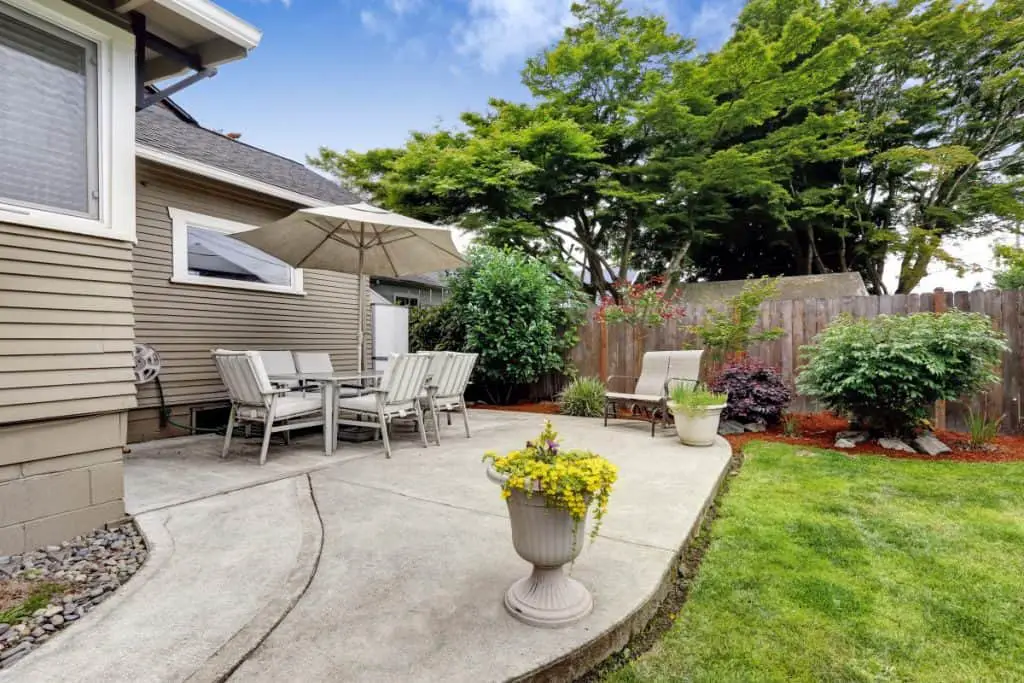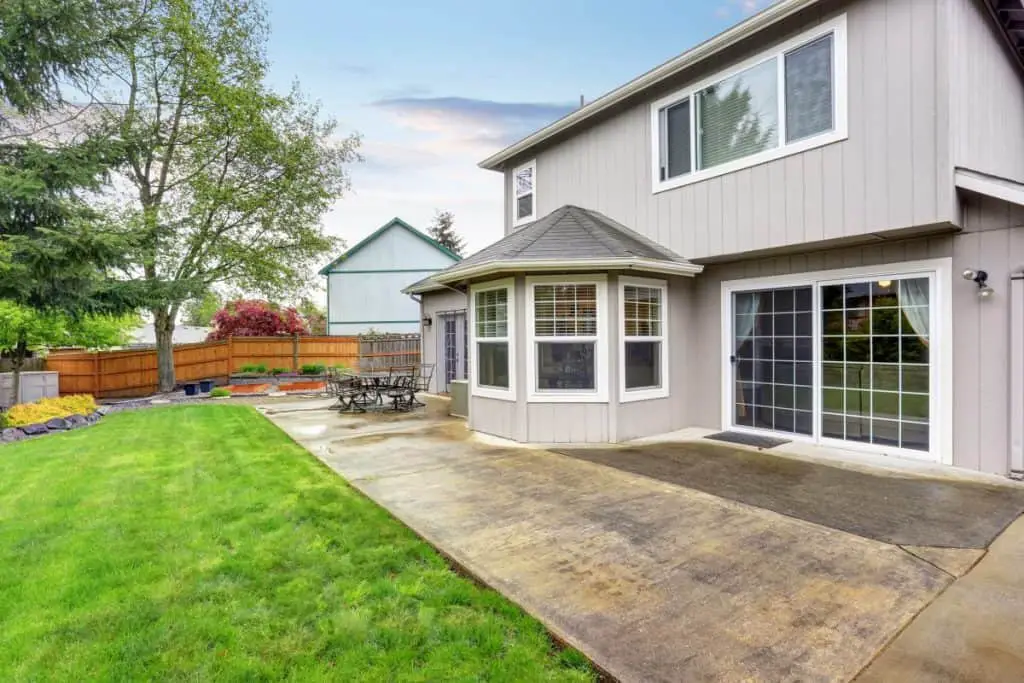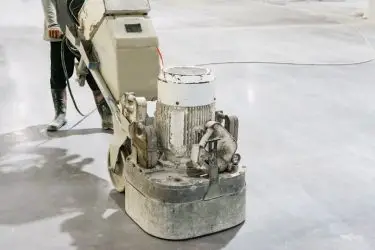Building a concrete patio can often be a challenging and stressful affair, especially when it comes to choosing its ideal dimensions. The perfect patio height can widely vary depending on your personal preferences and desired design aesthetic. However, to optimize functionality, there are some general rules to keep in mind when it comes to the distance between your concrete patio and the surrounding grass.
A concrete patio should not be flush with the grass. Ideally, a concrete patio should be about 1 inch (2.54 cm) higher than the ground surrounding it. This height difference serves both functional and aesthetic purposes.
In this article, I’ll delve more into what makes this elevation level ideal and how to safely and efficiently go about raising the height of your concrete patio when it’s flush with the grass.

Table of Contents
What’s the Ideal Height for a Concrete Patio?
The ideal height for a concrete patio is in between 0.5 and 1.5 inches (1.27 and 3.81 cm). This elevation level keeps grass, dirt, and other debris from falling onto your patio and prevents water from collecting inside it in case of heavy rains.
As you can see, keeping a certain distance between your build and the ground surrounding it serves several purposes. When the two surfaces are level, there’s a high chance of weeds and other impurities from the outside being transported into the concrete area, making it harder and more time-consuming to clean.
Additionally, the surrounding grass often provides the necessary drainage area that prevents the build from overflowing in cases of heavy rain. However, it wouldn’t be able to serve this purpose if it weren’t for the height difference between the two surfaces.
In order for this process to successfully happen, you’ll need to equip your patio with an adequately placed slope. Through this addition, the water will roll off the build into the lawn.
The benefits reaped from this phenomenon are multifold, as not only does it keep the patio from overflowing, but it also helps your lawn maintain its growth and aesthetic better, as it prevents soil erosion.
For this reason, adding a slope to your patio is crucial; otherwise, the one-inch (2.54 cm) height difference would serve little to no purpose. Therefore, if you feel confident in your skillset and the adequacy of your toolbox, you can attempt to build yourself by following this simple guide.

Ultimately, the ideal height for your particular patio can widely vary depending on a variety of factors. Not all homeowners have the same space, preferences, and design goals; therefore, the general rule you should keep in mind is to always aim for a balance between structural efficiency and aesthetics.
I referenced the 0.5 to 1.5 inches (1.27 to 3.81 cm) range more as a general guideline, as depending on the previously mentioned factors, the ideal height for you could be a few inches higher or lower. However, I wouldn’t recommend going much lower due to the reasons discussed in the preceding paragraph.
For example, while some might even want to put steps on their patio and create a completely separate area from their lawn, others might not even be able to elevate it a full inch.
Additionally, keep in mind that quality and amount of materials can be just as important as surface elevation when it comes to your build’s structural integrity. For this reason, if you’re still in the planning phases, make sure to opt for the highest-quality material your budget allows, as the investment will pay off in the long term.
Material quality and adequacy are especially important when it comes to higher platforms, which will need higher levels of support to maintain their sturdiness for extended periods of time. This is why you’ll always want to find the right balance between stability and elevation when building a new patio.
The Right Patio Slope
I’ve already covered the importance of a well-built patio slope, but how should this component be built in order to maximize its efficiency.
Generally speaking, the ideal slope tilt is around 2%. However, going a percentage lower or higher can yield a highly efficient end result; therefore, when deciding on the ideal choice for you, keep in mind your design and functionality goals.
This elevation angle will help the collected water roll off faster, preserving the quality and longevity of your patio’s materials. However, those wanting to maintain a more level appearance between their build and the ground surrounding it can opt for a less visible, 1% tilt.
However, this addition doesn’t only keep your patio safe, but you as well, as excessive water retention could also make the surface more slippery, turning into a safety hazard for your family. Furthermore, you’ll have to worry way less about watering your grass, as the plants will be well-hydrated due to receiving the patio’s collected water as well.
Does a Concrete Patio Have To Be Higher Than the Grass?
A concrete patio doesn’t have to be higher than the grass. In fact, many homeowners believe the flush setup gives their home a more modern and aesthetically pleasing look. However, a flush patio may collect excessive dirt and debris and require frequent maintenance.

Technically speaking, there’s nothing stopping you from building a patio that’s flush with the grass, as it can still add a lot to your property, both design and functionality-wise. However, when it comes to practicality, building the patio a few inches higher than the ground is always best to prevent rainwater from flooding and avoid the creation of any tripping hazards.
Not only does this setup offer the previously mentioned advantages, but it also keeps weeds and other harmful growths from spreading throughout your lawn, helping both surfaces simultaneously.
Furthermore, an elevated patio is also better for the ground it’s placed on. If excess water were to collect within the build, it would quickly find its way down through cracks and openings and wet the soil underneath it, affecting its sturdiness and durability. This process would lead to your patio slowly sinking over time, resulting in costly ramifications.
Tips to Optimize a Concrete Patio Flush With the Grass
If your patio is level with the grass, you might be wondering how to raise it yourself.
Unfortunately, the idea of simply raising your build, although straightforward in theory, can be very flawed in practice. A project of this size would require an excessive amount of time, money, and effort, thus rendering it pointless.

However, there are some ways you can optimize the distance you already have between your patio and the grass surrounding it:
- Frequently manicure your lawn. This prevents the grass and weeds from crawling onto the patio. Having said that, be careful not to cut it too short, as doing so can deter its look, feel, and overall health.
- Add a French drain to your build. This will allow the water to better run off of the patio without having the chance to collect and cause structural damage to it.
- Consider a full patio replacement. This can be a costly and time-consuming affair and should be treated as a last resort. Still, if you feel like your current setup is causing more damage than you’re willing to repair, it might be a worthy replacement.
Conclusion
Although depending on your preferences, there are no physical limits when it comes to the type of patio you can build, generally speaking, the structure shouldn’t be level with the grass surrounding it.
A slight elevation level could help you maintain your outdoor build much easier while also keeping the lawn healthier overall. Additionally, this setup is safer and optimizes the structure’s durability and longevity.




